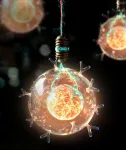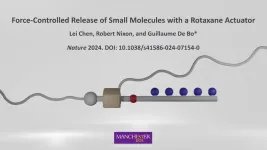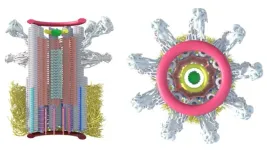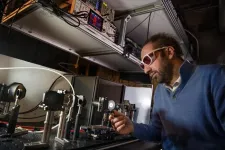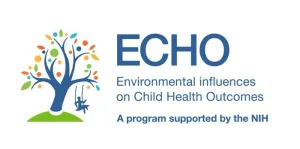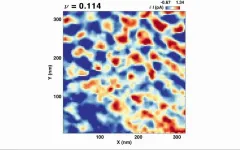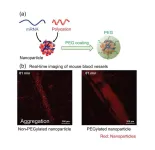(Press-News.org) As lung cells are killed by the influenza virus, they burst open, releasing molecular signals that trigger the immune cells that can combat the infection. This strategy can be an important red flag that something is wrong; however, if one cell death response, called necroptosis, continues unchecked, it can cause life-threatening injury to lung tissue. In a study published April 10 in the journal Nature, Tufts University School of Medicine scientists and collaborators present a newly developed compound capable of reversing the course of infection in mice by blocking necroptosis.
There are currently few therapeutic options available to reverse the course of a serious flu infection other than to manage symptoms until the body can combat the virus on its own. With prior evidence showing that lung injury can be caused by influenza-induced necroptosis, the researchers showed that a compound called UH15-38 can safely and efficiently block the key receptor in lung cells undergoing necroptosis without intolerable side effects.
“If you remove necroptosis, you still get restriction of the viral replication without causing the massive damage to the lungs,” says Alexei Degterev, an associate professor of developmental, molecular and chemical biology at Tufts University School of Medicine and a co-corresponding author on the study. “Necroptosis does not appear to be necessary for restricting a viral activity, so if we can block it, we will be able to protect the host by reducing inflammation in the lungs.”
Necroptosis is triggered when a cell under duress activates its receptor interacting protein kinase 3 (RIPK3) pathway, thereby attracting immune cells to the area. UH15-38 reduces excessive inflammation by inhibiting the activation of the RIPK3 pathway. Not only did UH15-38 prove to be well-tolerated in mice, but it successfully prevented any influenza deaths, even when administered up to five days into the course of an infection.
The researchers note that if the results from the mouse studies extend into further preclinical and human trials, compounds like UH15-38 could potentially address the most severe flu infections as well as other viruses that trigger severe respiratory symptoms. The value of the approach is how it addresses the inflammation that is intended to be protective but can do more harm than good.
“While the worst of COVID-19 may be behind us, the credible expectation is that there will be another pandemic that’s going to happen and we need something that is going to protect the host independent of how the host is infected,” says Degterev. “This work highlights the possibility of achieving such a goal and renews interest in how cell death shapes infections.”
Tufts University researchers helped organize the study and provided key insights into the UH15-38 inhibitor, but these results would not have been possible without investigators at multiple institutions—including Fox Chase Cancer Center, the University of Houston, and St. Jude Children’s Research Hospital—working closely together.
Degterev and his co-collaborators are now pursuing the second generation of these inhibitors. They are also continuing to test how UH15-38 and related compounds can protect against other respiratory diseases. The commercialization of UH15-38 is being managed by Tufts University’s Office for Technology Transfer and Industry Collaboration.
Ioannis Siokas of Tufts Graduate School of Biomedical Sciences and Dingqiang Zhang, formerly of Tufts University School of Medicine, are also authors on the paper.
Complete information on authors, methodology, funders, and conflicts of interest is available in the published paper. The content is solely the responsibility of the authors and does not necessarily represent the official views of the funders.
END
Serious flu damage prevented by compound that blocks unnecessary cell death
Scientists test therapeutic strategy that reduces lung injury and inflammation caused by an overactive immune response to the flu virus
2024-04-10
ELSE PRESS RELEASES FROM THIS DATE:
CHOP, Stanford researchers identify protein that controls CAR T cell longevity
2024-04-10
Philadelphia, April 10, 2024 – CAR T cell therapy has revolutionized the way certain types of cancer are treated, and the longer those CAR T cells live in a patient’s body, the more effectively they respond to cancer. Now, in a new study, researchers at Children’s Hospital of Philadelphia (CHOP) and Stanford Medicine have found that a protein called FOXO1 improves the survival and function of CAR T cells, which may lead to more effective CAR T cell therapies and could potentially expand its use in difficult-to-treat cancers. The findings were published online today by the journal Nature.
T ...
Race, ethnicity, and delayed time to COVID-19 testing among health care workers
2024-04-10
About The Study: In this cross-sectional study of health care personnel (HCP), compared with non-Hispanic white HCP and clinical HCP with graduate degrees, non-Hispanic Black HCP, non-Hispanic HCP of other races, and HCP of all other professional and education backgrounds were more likely to have delayed COVID-19 testing. These findings suggest that time to testing may serve as a valuable metric in evaluating sociodemographic disparities in the response to COVID-19 and future health mitigation strategies.
Authors: DaMarcus ...
Trends in deaths of despair by race and ethnicity
2024-04-10
About The Study: As of 2022, the midlife mortality rates from deaths of despair (deaths from suicide, drug overdose, and alcoholic liver disease) among Black individuals were higher than rates among white individuals, and rates among American Indian or Alaska Native individuals remained higher than rates in the other groups. Rising inequalities in deaths of despair among American Indian or Alaska Native and Black individuals were largely attributable to disproportionate early mortality from drug- and alcohol-related causes, which increased leading up to and during the COVID-19 pandemic.
Authors: Joseph ...
Revolutionary molecular device unleashes potential for targeted drug delivery and self-healing materials
2024-04-10
In a new breakthrough that could revolutionise medical and material engineering, scientists have developed a first-of-its-kind molecular device that controls the release of multiple small molecules using force.
The researchers from The University of Manchester describe a force-controlled release system that harnesses natural forces to trigger targeted release of molecules, which could significantly advance medical treatment and smart materials.
The discovery, published today in the journal Nature, uses a novel technique using a type of interlocked molecule known as rotaxane. Under the influence of mechanical force - such ...
The genesis of our cellular skeleton, image by image
2024-04-10
Cells contain various specialised structures - such as the nucleus, mitochondria or peroxisomes - known as “organelles’’. Tracing their genesis and determining their structure is fundamental to understanding cell function and the pathologies linked to their dysfunction. Scientists at the University of Geneva (UNIGE) have combined high resolution microscopy and kinematic reconstruction techniques to visualise, in motion, the genesis of the human centriole. This organelle, essential to the organisation of the cell skeleton, is associated - in case of dysfunction - with certain cancers, brain disorders or retinal diseases. This work, published in the journal Cell, elucidates ...
Quantum breakthrough when light makes materials magnetic
2024-04-10
The potential of quantum technology is huge but is today largely limited to the extremely cold environments of laboratories. Now, researchers at Stockholm University, at the Nordic Institute for Theoretical Physics and at the Ca’ Foscari University of Venice have succeeded in demonstrating for the very first time how laser light can induce quantum behavior at room temperature – and make non-magnetic materials magnetic. The breakthrough is expected to pave the way for faster and more energy-efficient computers, information transfer and data storage.
Within a few decades, the advancement of quantum technology ...
Living near green space associated with fewer emotional problems in preschool-age kids, NIH study finds
2024-04-10
Children who live in areas with natural spaces (e.g., forests, parks, backyards) from birth may experience fewer emotional issues between the ages of 2 and 5, according to a study funded by the NIH Environmental Influences on Child Health Outcomes (ECHO) program.
While research has suggested that time in nature is important for mental health, studies examining the effects on young children are limited. ECHO investigators addressed this research gap by analyzing information from parents about the behavior of their children from ages 2 to 11. They combined this data with the family’s ...
Researchers explore role of androgens in shaping sex differences
2024-04-10
Sex differences are widespread across human development, physiological processes, and diseases, making it important to characterize the impact of sex differences in these areas. Understanding the regulatory mechanisms associated with these differences, including the role of androgens, is also vital for clinical translation—especially for diseases more prevalent in one sex.
To answer these questions, a team led by Prof. GAO Dong and Prof. CHEN Luonan from the Center for Excellence in Molecular Cell Science, Shanghai Institute ...
Quantum crystal of frozen electrons—the Wigner crystal—is visualized for the first time
2024-04-10
Electrons—these infinitesimally small particles that are known to zip around atoms—continue to amaze scientists despite the more than a century that scientists have studied them. Now, physicists at Princeton University have pushed the boundaries of our understanding of these minute particles by visualizing, for the first time, direct evidence for what is known as the Wigner crystal—a strange kind of matter that is made entirely of electrons.
The finding, published in the April 11th issue of the journal Nature, confirms a 90-year-old ...
A new coating method in mRNA engineering points the way to advanced therapies
2024-04-10
Researchers from Tokyo Medical and Dental University (TMDU) have developed a novel method for chemically modifying engineered messenger RNA molecules, allowing greater control of their biological functions and advancing mRNA therapeutic technologies
Tokyo, Japan – Medicine can help to treat certain illnesses, e.g., antibiotics can help overcome infections, but a new, promising field of medicine involves providing our body with the “blueprint” for how to defeat illnesses on its own.
mRNA therapeutics ...
LAST 30 PRESS RELEASES:
The (metabolic) cost of life
CFRI special issue call for papers: New Frontiers in Sustainable Finance
HKU Engineering scholar demonstrates the smallest all-printed infrared photodetectors to date
Precision empowerment for brain "eavesdropping": CAS team develops triple-electrode integrated functional electrode for simultaneous monitoring of neural signals and chemical transmitters during sleep
Single-capillary endothelial dysfunction resolved by optoacoustic mesoscopy
HKU three research projects named among ‘Top 10 Innovation & Technology News in Hong Kong 2025’ showcasing excellence in research and technology transfer
NLRSeek: A reannotation-based pipeline for mining missing NLR genes in sequenced genomes
A strand and whole genome duplication–aware collinear gene identification tool
Light storage in light cages: A revolutionary approach to on-chip quantum memories
Point spread function decoupling in computational fluorescence microscopy
BacPhase: Long-insert paired-end sequencing for bin marker construction and genome phasing
GmWOX1 regulates the mediolateral polarity of compound leaves in soybean
ChargeFabrica: An open-source simulation tool that aims to accelerate search for high performance perovskite solar cells
High levels of ADAR overexpression induce abundant and stochastic off-target RNA editing in rice protoplasts
On-demand upgraded recycling of polyethylene and construction of sustainable multifunctional materials based on the "LEGO" strategy
New "Stomata in-sight" system allows scientists to watch plants breathe in real-time
Anorexia nervosa may result in long-term skeletal muscle impairment
Narrative-based performance reviews deemed fairest by employees
New insights reveal how advanced oxidation can tackle emerging water pollutants
New review shows how biomass can deliver low-carbon gaseous fuels at scale
Climate change is quietly rewriting the world’s nitrogen cycle, with high stakes for food and the environment
Study finds SGLT-2 inhibitors linked to lower risk of diabetic foot nerve damage
Microbes may hold the key to brain evolution
Study examines how the last two respiratory pandemics rapidly spread through cities
Gender stereotypes reflect the division of labor between women and men across nations
Orthopedics can play critical role in identifying intimate partner violence
Worms as particle sweepers
Second spider-parasitic mite described in Brazil
January 2026 issues of APA journals feature new research on autism, pediatric anxiety, psychedelic therapy, suicide prevention and more
Private equity acquired more than 500 autism centers over the past decade, new study shows
[Press-News.org] Serious flu damage prevented by compound that blocks unnecessary cell deathScientists test therapeutic strategy that reduces lung injury and inflammation caused by an overactive immune response to the flu virus
